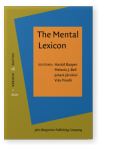Vol. 16:1 (2021) ► pp.133–164
Testing the storage of prosody-induced phonetic detail via auditory lexical decision
A case study of noun/verb homophones
This article reports the results of an auditory lexical decision task, testing the processing of phonetic detail of English noun/verb conversion pairs. The article builds on recent findings showing that the frequent occurrence in certain prosodic environments may lead to the storage of prosody-induced phonetic detail as part of the lexical representation. To investigate this question with noun/verb conversion pairs, ambicategorical stimuli were used that exhibit systematic occurrence differences with regard to prosodic environment, as indicated by either a strong verb-bias, e.g., talk (N/V) or a strong noun-bias, e.g., voice (N/V). The auditory lexical decision task tests whether acoustic properties reflecting either the typical or the atypical prosodic environment impact the processing of recordings of the stimuli. In doing so assumptions about the storage of prosody-induced phonetic detail are tested that distinguish competing model architectures. The results are most straightforwardly accounted for within an abstractionist architecture, in which the acoustic signal is mapped onto a representation that is based on the canonical pronunciation of the word.
Article outline
- 1.The storage of phonetic detail
- 1.1Prosody and lexical representation
- 1.2The present study
- 2.Method
- 2.1Participants
- 2.2Creation of stimuli
- 2.3Acoustic analysis of stimuli
- 2.4Procedure
- 2.5Modeling reaction times and accuracy
- 3.Results
- 4.Discussion
- 5.Conclusion
- Acknowledgements
-
References
